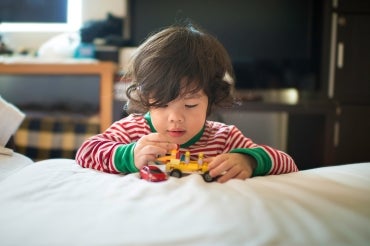Ten ways to teach your kids through play during COVID-19: U of T expert

Published: May 13, 2020
As many parents have come to realize during COVID-19, teaching your children can be quite challenging. Children are used to you acting as a parent – not a teacher, according to child development expert Angela Pyle of the Ontario Institute for Studies in Education (OISE) at the University of Toronto.
But Pyle, who is an assistant professor in OISE’s department of applied psychology and human development and runs Play Learning Lab at the Dr. Eric Jackman Institute of Child Study, says play-based learning can provide a developmentally appropriate context for learning skills in an engaging manner that is less stressful.
While play is traditionally conceived as a child’s activity rather than a serious learning context, research has found that the integration of academic learning in play-based contexts is often more successful than traditional adult-led learning. There are many ways to integrate play and learning, including both adult-led and child-led approaches, Pyle says.
Pyle recently put together a list of 10 ways to encourage children’s learning at home through play:
Language and play
1. Hide letters around your house and go on a letter hunt. Have younger children identify the letters and their sounds. Invite older children to make as many words as they can using the letters they find.
2. To help children learn to blend letter sounds, an essential reading skill, play hide-and-seek. Choose a favourite toy and hide it in the house. Invite your child to find the toy with the help of a clue. For example, sound out the letters of the word that describes the hiding place (e.g., “The car is under the t-a-b-l-e.”). Your child can blend the sounds together to solve the clue and find their toy.
3. Invite your child to choose one of their favourite toys to be the character in a play or movie. Younger children can identify the parts of the story – character, setting, problem, solution – orally. Older children can write the outline, while more capable children can write a full script. Then perform a live play or create a movie of their story.
Math and play
4. Use Lego to practice basic math skills. Have younger children roll a die and build a tower with that many blocks. Older children can roll two dice and add the numbers together to determine how many blocks to put in their tower. More advanced learners can roll two dice, using the first to identify the number of towers to build and the second to represent the number of blocks in each tower. Children can then write out and answer the corresponding multiplication sentence, using the blocks as counters if needed.
5. Board games support the development of number skills as children roll dice and count out the appropriate number of spaces to move in games like Snakes and Ladders, and Candyland. For older children, strategy games like Blokus that develop their spatial awareness are a good option.
6. To work on your child’s visual spatial skills, present them with a building challenge. Build a simple structure out of blocks. Show the structure to your child for five seconds and then hide it. Challenge your child to visualize the object and build it from memory. Once complete, show the original structure and allow them to compare the two.
Science and play
7. Building things can promote learning of the scientific process as children experiment with different ways to make structures more stable. For instance, they could build a roller coaster out of Lego and tracks out of cardboard and other household items. You can extend this learning by asking purposeful questions: How can you ensure that the roller coaster arrives at the end of the track without stopping? How can you make the roller coaster travel faster?
8. A common household item like an ice cube can provide the inspiration for both science and art. Experiment with melting ice cubes by using household items like salt or a hair dryer. Measure and compare how quickly each item causes the ice cube to melt, then ask your children for their theories about what they have observed. Add food colouring to the ice cubes using primary colours to experiment with colour mixing. What happens when a red ice cube and a purple ice cube melt and mix together? Use this knowledge to create beautiful art by rubbing the ice cubes on paper as they melt.
Integrating learning and imaginative play
9. In this unusual time, many children wish they could go somewhere beyond their homes. Turn this frustration into an inspiration for play. Learn about a place your child would like to go by reading about it or watching videos online. Make a pretend airplane and invite your child to create passports, boarding passes, travel brochures and signs for your trip. This type of play scenario provides the opportunity to practice both reading and writing while engaging in imaginative play.
10. Invite your child to build a fort that can serve as the inspiration and location for learning. They can draw plans for their fort prior to construction. More capable learners can label these plans and write a list of the materials they will need. Children can give their fort a name and make signs containing the name and any rules that they wish those inside the fort to abide by. The fort can also provide a cozy place to read together. Both inviting your child to read and reading to your child are valuable to their learning. When your child reads they practice using strategies to decode words and read fluently. Reading to your child provides the opportunity for them to hear what fluent reading should sound like, expand their vocabulary and hear stories that they may not yet be able to read on their own.



